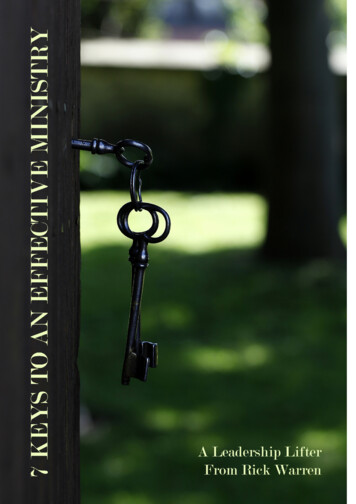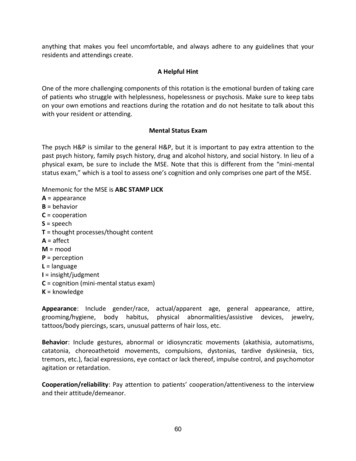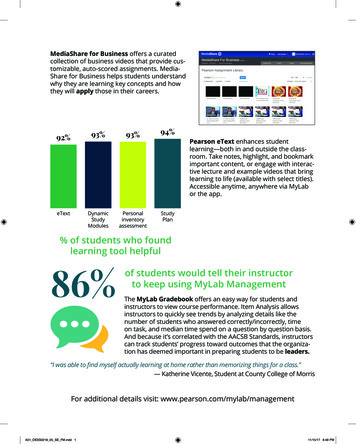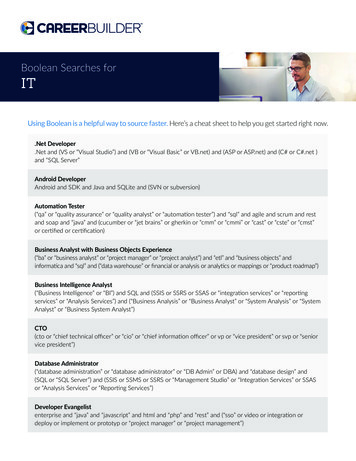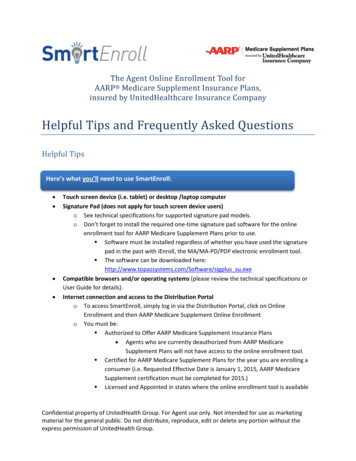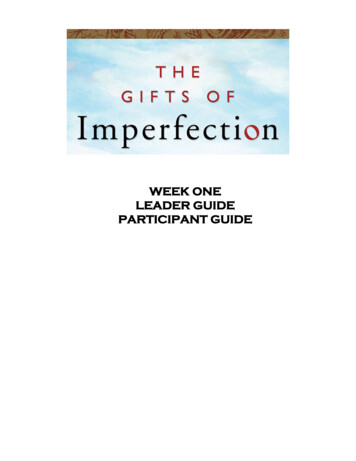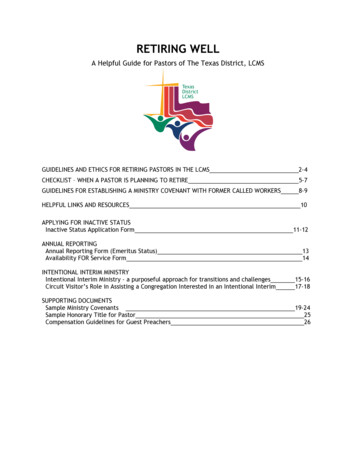
Transcription
RETIRING WELLA Helpful Guide for Pastors of The Texas District, LCMSGUIDELINES AND ETHICS FOR RETIRING PASTORS IN THE LCMS2-4CHECKLIST – WHEN A PASTOR IS PLANNING TO RETIRE5-7GUIDELINES FOR ESTABLISHING A MINISTRY COVENANT WITH FORMER CALLED WORKERS8-9HELPFUL LINKS AND RESOURCES10APPLYING FOR INACTIVE STATUSInactive Status Application FormANNUAL REPORTINGAnnual Reporting Form (Emeritus Status)Availability FOR Service Form11-121314INTENTIONAL INTERIM MINISTRYIntentional Interim Ministry - a purposeful approach for transitions and challengesCircuit Visitor’s Role in Assisting a Congregation Interested in an Intentional Interim15-1617-18SUPPORTING DOCUMENTSSample Ministry CovenantsSample Honorary Title for PastorCompensation Guidelines for Guest Preachers19-242526
GUIDELINES AND ETHICS FOR RETIRING PASTORS IN THE LCMSIntroduction:As we currently face a record number of pastors arriving at the age and opportunity forretirement, a need for some basic guidelines seems necessary as many of the customs andhabits understood and practiced by previous generations are often ignored. Understandingthat realities like the economy, good health, longevity of life, etc., also play a role, theseguidelines are offered to help maintain the “unity of the Spirit in the bonds of peace.” (Eph.4:3)Retirement is normally a well-earned time of transitioning into new forms of ministry that canbe just as rewarding and fulfilling as earlier ones. While “forced” retirement does indeedhappen from time to time, this is often the exception and should be dealt with throughecclesiastical supervision. However, no matter what, clear boundaries need to beunderstood, both from the pastor retiring and the congregation from which he is retiring.Announcement and TransitionWhen a pastor determines that he will retire he should help prepare the congregation,spiritually, mentally, and physically, for the transition and inform them of what to expectonce the transition has been made. Normally, the pastor should wait to formally announcehis retirement until 6 months before, although he may indicate to the leadership sooner. Ifannounced too early there is a danger of a “lame duck” mentality that could form, preventingmeaningful ministry from occurring. To wait too long and announce a month or weeks priorleaves a congregation ill prepared to meet the challenges ahead.The circuit visitor or district president or his representative should be invited to share withthe church's leadership, and then with the entire congregation, what to expect with theretirement of their former pastor and what the appropriate parameters will be of anycontinuing relationship with the retiring pastor. At this point the district president or circuitvisitor would also outline the future process for calling a new pastor, proper timing, interimministry, etc. This should never come from the retiring pastor. It is best that he instruct hispeople to not do anything until they have spoken with the circuit visitor or district president.When people have not been informed, or their concerns heard, they often put demands onthe former pastor without knowing or understanding the ethical boundaries for the well-beingof the total congregation. They also may make poor decisions regarding the future of theparish. Good knowledge can assist everyone in maintaining friendship ties while carefullysevering pastoral ones and planning for the future. It also allows for mourning the loss whilecelebrating what has been meaningful in the past, and looking to the future.Congregations must be taught the appropriate boundaries so as not to place a retired pastorin an awkward position. Any effort to involve a former pastor, retired pastor, or otherMinister of Word and Sacrament in any issues between members and the current pastor willonly confuse the situation and make matters worse. It will also put the former pastor, retiredpastor, or other Minister of Word and Sacrament in an untenable ethical situation. Whilemembers of congregations are encouraged to avoid putting a pastor in such a position, itremains the responsibility of the pastor to maintain the appropriate boundaries.Retirement does involve change, and that can be as exciting and freeing as the choicesavailable. However, it does mean letting go of the former, to trust God into the future. HisReturn to Table of ContentsRetiring Well - Texas District LCMS P: 512.926.4272 TF: 800.951.3478 www.txlcms.org 2
Word in Jeremiah 29:11 also applies to the pastor: “For I know that plans I have for you”declares the Lord, “plans to prosper you and not to harm you, plans with hope and a future.”What is yet in store can be a rich time of ministry and personal adjustment to a lessenedschedule. Each cycle of ministry brings its own rewards. Trusting God to lead you forwardwithout holding onto the past is important.Roster StatusA retired pastor is on the roster of the District in which last under call or in which the pastorresides. The retired pastor remains accountable to the district president where rostered. Itis understood that a retired pastor must be a member in good standing of an LCMScongregation in order to remain on the roster of ordained ministers and remains subject tothe same standards for ordained ministers of the church.GuidelinesWith more retiring pastors owning homes within the community of their last pastorate carefulattention must be given to the church's well-being and that of the new pastor called to servethat church. With this concern in mind, the Council of Presidents of The Lutheran Church—Missouri Synod sets forth the following as ethical guidelines for retiring pastors.1. It is recommended, upon retirement, that a pastor sever all pastoral ties with thosepreviously served in the local parish. This includes weddings, funerals, pastoral callsand visits, and especially giving advice and counsel, and in any way continuing theprevious pastoral relationships. This also involves attending church functions andservices until an agreement can be made with the new pastor. The retired pastorshould have little to no contact with the ministry, nor should he serve it in anycapacity, either professionally or as a volunteer because of the sphere of influence hestill has. Continuing ties of friendship is one thing, pastoral ties is another.He is no longer the pastor of this parish.2. It is prudent for a retired pastor that he consider not remaining a member of thecongregation served at the time of retirement. Transferring one’s membership toanother congregation is very helpful to aid the successor pastor to assume pastoralleadership more readily. It also provides an opportunity for the retired pastor to enterfully into the life of a different congregation with clarity about the pastor’s retiredrole. One area of potential service for the retired pastor is interim (pastoral vacancy)ministry (or, with training, Intentional Interim Ministry). Many retired pastors providevaluable and needed ministry to congregations in time of transition following theresignation of a pastor. This is a way to honor our Lord and continue serving HisChurch.3. If remaining within the community last served, the retiring pastor ought not attendthe church previously served for a period of at least six months to one year followingthe retirement. Visits following that period will be at the invitation of the InterimMinister or the new pastor. Participation in baptisms, weddings and funerals should beby invitation of the Interim Minister or new pastor. Persons not associated with thechurch should be encouraged to form a relationship with the church and its InterimMinister or new pastor.4. Once the new pastor is in place, the relationship between the new pastor and theformer pastor with the church he formerly served can be worked out. If a satisfactoryReturn to Table of ContentsRetiring Well - Texas District LCMS P: 512.926.4272 TF: 800.951.3478 www.txlcms.org 3
and workable mutual agreement cannot be reached between them, they may wish toconsult with the circuit visitor or district president.5. It is imperative that members avoid discussing issues concerning the congregation, thecurrent pastor, the staff, the Circuit, or any other aspect of congregational life with aformer pastor or other ordained minister, or even members worshipping within thecongregation. Such discussions are likely to be perceived as soliciting advice orcounsel on church matters. It is in his best interest and for the health and welfare ofthe church, as well as the Kingdom, that a former pastor distance himself from thecongregation and that other ministers not usurp the relationship between the currentpastoral leadership and the congregation.6. When a former pastor is named Pastor Emeritus, it needs to be understood by theformer pastor and the congregation that this is an honorary title and does not imply orinclude any pastoral duties or responsibilities. The retiring pastor should alwayssupport and guard well the role of the new pastor.7. It is disruptive for a pastor to succeed himself as Interim Minister of the churchimmediately served. Upon retirement, the pastor will sever all pastoral ties with theformer congregation. This allows for the church to call an Interim Minister to serve asa bridge between the former pastor and the calling of a new one, and to assist thecongregation in its grieving process. A violation of this is a breach of ministerial ethicsand may potentially interfere in some one’s divine call.8. Whenever a pastor is to remain within the community of a church just served, theirrelationship to that church, its Interim Minister, and its newly called pastor shall beevaluated with the wellbeing of that church in mind. What evolves as a workingrelationship must give first priority to the needs of the church. Individuals' needs areimportant but must not take priority. The relationship of former pastor, InterimMinister and new pastor must reflect the needs of the church.Return to Table of ContentsRetiring Well - Texas District LCMS P: 512.926.4272 TF: 800.951.3478 www.txlcms.org 4
CHECKLIST – WHEN A PASTOR IS PLANNING TO RETIREWhen planning to retire, a pastor needs to address issues in the following four (4) realms: SocialSecurity, Concordia Retirement Plan, LCMS roster status, and the congregation/ministrybeing served.Set a specific date for your retirement. Do not tell the congregation that you plan toretire “in about a year or so.”Inform the congregation, in writing, of the date of your retirement. Under normalcircumstances, three (3) to six (6) months’ notice is sufficient time for the congregationto plan for your departure and the ensuing vacancy. If there are extenuatingcircumstances, a longer time period can be given to allow the congregation to preparefor the calling of a new pastor. Send a copy of your letter to the congregation to theDistrict President.Contact Concordia Plan Services, if you are eligible to receive Concordia RetirementPlan benefits, at least three (3) to five (5) months before your retirement date to ensureenough time to receive and complete the required retirement application.Contact the Social Security Administration, if you are eligible to apply for S.S. benefits,at least two (2) months prior to the date when you want to begin receiving thosebenefits.Apply for Emeritus Status by contacting the District President or his AdministrativeAssistant. This is required in bylaws of the Synod (Bylaws 2.11.2 – 2.11.2.1) to remainon the clergy roster of the Synod.Allow the congregation to “mourn” your retirement.Allow the congregation to give thanks to God for your ministry by hosting a retirementevent for you and your family.If you are named pastor emeritus by the congregation you have served, recognize thatthis is an honorary title and that it does not imply or include any pastoral duties orresponsibilities. See the sample resolution in the supporting document section of thisdocument.Bring closure to your ministry. Announce publicly and repeatedly that you will no longer be the pastor ofthe congregation. Make sure that all official records are up-to-date. Develop a transition plan for the church, determining who needs to knowwhat you know, and transmit that information to them so that life in thecongregation can continue smoothly without you. Start cleaning out your office as soon as you announce yourretirement. There is so much that you will need to sort through and do andthe time flies by faster than you can imagine. You should not plan on goingback to the office after you retire to finish cleaning things up. When youReturn to Table of ContentsRetiring Well - Texas District LCMS P: 512.926.4272 TF: 800.951.3478 www.txlcms.org 5
walk out the door on the day you retire, you should be totally done and allof your belongings should be out of the church. Make sure that you have something to do IMMEDIATELY to fill your time afteryour final day in office. That may be taking a trip, working on your house,pursuing a hobby, etc. The point is, PLAN NOW for what you are going to bedoing the morning you wake up retired. Prepare for potential loneliness to set in. The chances are the phone callswill stop, the emails will stop, and no one will call to say ”hi” or to ask howyou are doing, not even your former staff members. Life and ministry in thecongregation moves on for everyone else – without you. Be prepared for thatto take place.Good pastoral practice dictates that you do what you can to make sure that yoursuccessor is accepted by the members of the congregation and effective in his ministry.If possible, join a sister congregation. If distance prohibits this or it is impractical forsome other reason, you should establish a ministry covenant with the congregation priorto your retirement. The covenant should set strict boundaries for you to remain in thecongregation. The document should be signed and dated by you and the chairman ofthe congregation. It should be reviewed, modified if necessary, signed, and dated onan annual basis.If you remain in the congregation, you should be absent for at least a year after youretire, especially after the new pastor arrives.Be firm in maintaining appropriate boundaries Upon retirement, sever all pastoral ties with those you have previously servedas the pastor of the congregation. Refuse to triangulate the new pastor in any way. Refuse to conduct or participate in any official acts. Refuse to hold an office in the congregation or serve on any boards orcommittees. Refuse to counsel members of the congregation. Refuse to teach any classes in the congregation. Refuse to attend any meetings, including those held in the parking lot. Refuse to serve as the vacancy pastor during the call process. Refuse to preach in the congregation. Refuse to serve as the visitation pastor of the congregation. Refuse to participate in any way in the call process. Don’t tell members, “I’ll be happy to do this if the new pastor says it’s okay.” Only consider doing something in the congregation if the request is initiatedby the new pastor. Don’t say anything publicly or privately which would undermine the ministryof the new pastor.If you are the Circuit Visitor, ask the District President to appoint someone else to handlethe call process in the congregation.Return to Table of ContentsRetiring Well - Texas District LCMS P: 512.926.4272 TF: 800.951.3478 www.txlcms.org 6
If your wife is involved in the life of the congregation (e.g., organist, secretary, chair ofthe women’s group, etc.), she should resign those positions.If the retiring pastor has grown children who are in leadership positions in thecongregation, he should discuss with them the wisdom and challenges of their futureinvolvement in the congregation once a new pastor arrives.Return to Table of ContentsRetiring Well - Texas District LCMS P: 512.926.4272 TF: 800.951.3478 www.txlcms.org 7
GUIDELINES FOR ESTABLISHING A MINISTRY COVENANT WITH FORMER PASTORS(See Sample Ministry Covenant in the Support Document Section)Any Pastor ending his service to a congregation for any reason should be strongly encouragednot to retain membership, or to continue to attend at that congregation.If a Pastor ending his service to a congregation for any reason desires to retain hismembership there or to continue to attend, and the congregational leadership is amenable,the following guidelines are encouraged.I. Introducing the Ministry CovenantThe goal of this document is to assist the former pastor, representatives of the congregationand the new pastor to form a covenant agreement describing how they will support oneanother. While the needs of the former pastor and spouse are important, the well-being ofthe congregation and the relationship with their new pastor is the priority. A healthyrelationship with a former pastor can be a wonderful asset to the congregation and futureministry if all parties are able to work together in trust and love.If a covenant agreement is set in place prior to the arrival of the new Pastor it is to bereviewed within two months of the arrival of the new Pastor. Thereafter having an annualconversation and renewal of the covenant will give opportunity for the body of Christ to beedified.II. Components of A Ministry Covenant1. ThanksgivingA statement giving thanks for the ministry of the former pastor and spouse.2. Our Intentions for the immediate futureA. A statement from the pastor and spouse that describes their plans for churchinvolvement until the new pastor arrives.B. A statement from the congregation leaders and (when he arrives) the new pastor,identifying specific ways they will support the former pastor and his wifespiritually and relationally3. How We Live Out Our Agreement Given Certain SituationsA. A statement clearly stating that all parties recognize that the former Pastor is nolonger Pastor to the congregation.B. A statement describing how all parties to the covenant will handle requests forpastoral service from the former pastorC. A statement about attendance at weddings, funerals, baptisms when the formerpastor and spouse are specifically invited during the initial transition timeD. A statement about the role of the spouse of the former Pastor within thecongregationE. A statement about the pastor and spouse’s relationship with personal friendswithin the congregationF. A statement about emergency situations causing the covenant agreement to be setaside for a timeReturn to Table of ContentsRetiring Well - Texas District LCMS P: 512.926.4272 TF: 800.951.3478 www.txlcms.org 8
4. Covenant RenewalA. A statement describing involvement of former pastor and spouse within thecongregation based on their interest, and needs of the congregationB. A statement of how all parties to the covenant handle requests being made bycongregation members to the former pastorC. A statement describing the former pastor’s involvement in congregation decisionsespecially if he disagrees with the directionD. Identify how the covenant will be evaluated, by whom, and when5. Ecclesiastical Supervision.A. A copy of the Ministry Covenant shall be forwarded to the office of the DistrictPresident for his signature.Signature of Former Pastor and Spouse:Signature of Vacancy/Interim/Settled Pastor:Representative of Congregation:District President:Date:Proposed Renewal Date (within 12 months):III. Notes on the CovenantParties to the Covenant – The working principle behind a covenant is this: a covenantmanages agreement. The decision to put a covenant agreement in place is a proactivedecision to honor the relationship between all parties. The key parties include: The new pastor of the congregation The members of the congregation (represented by the leaders) The former pastor and spouseWhile representatives of the congregation represent the congregation in putting the covenantin place and administering the details of the covenant, the congregation needs to
Jan 12, 2021 · Security, Concordia Retirement Plan, LCMS roster status, and the congregation/ministry being served. _ Set a specific date for your retirement. Do not tell the congregation that you plan to retire “in about a year or so.” _ Inform the congregation, in
